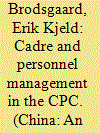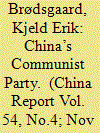| Srl | Item |
| 1 |
ID:
114588


|
|
|
|
|
| Publication |
2012.
|
| Summary/Abstract |
This article addresses some of the most important mechanisms and instruments in the Communist Party of China's (CPC) management of key officials and administrative personnel: Party and state cadres in administrative organs and institutions. These mechanisms include control over the administrative layout in terms of organs and positions (bianzhi), the authority to appoint leading personnel (nomenklatura), as well as a sophisticated cadre transfer system - which also involves rotation between big business and the political world. The article not only emphasises the crucial importance of cadre management in understanding the fundamentals of the Chinese power system, but it also points to a number of challenges in studying this particular Chinese form of personnel management. It shows the elaborate nature of cadre and personnel management in China and argues that in recent years the Party has strengthened rather than weakened its role in managing the cadre corps. Finally, the article draws on theoretical insights provided by the existing body of literature on elites in general and in relation to China in particular.
|
|
|
|
|
|
|
|
|
|
|
|
|
|
|
|
| 2 |
ID:
162353


|
|
|
|
|
| Summary/Abstract |
The Communist Party of China (CPC) is not withering away as predicted by some Western scholars. On the contrary, in recent years, the party has centralised and strengthened its rule over China. At the same time, party membership has changed. Today, workers and farmers only account for only one-third of the total party membership compared to two-thirds when the People’s Republic of China (PRC) was established. Instead, new strata and groups such as technical and management personnel have evolved. The composition of the party’s cadre corps has changed accordingly, and cadres today are younger and much better educated than during Mao’s time. The leading cadres form an elite which is at the heart of a ranking-stratified political and social system. This article discusses how the CPC has evolved from a mass to an elite party. It argues that in this process, the party has taken over the state resulting in a merger and overlap of party and government positions and functions, thereby abandoning Deng Xiaoping’s ambidextrous policy goals of separating party and government. Centralisation and reassertion of ranking-stratified party rule is Xi Jinping’s answer to the huge challenges caused by the economic and social transformation of Chinese society—not a return to Mao’s mass party.
|
|
|
|
|
|
|
|
|
|
|
|
|
|
|
|
| 3 |
ID:
158633


|
|
|
|
|
| Summary/Abstract |
Existing literature on China’s Performance Evaluation System and how it shapes cadre behavior tends to assume a hierarchy of work targets either through the framework of soft targets, hard targets, and priority targets with veto power or through target measurability. However, this traditional conceptualization of target hierarchy can no longer capture the nature of content of today’s Performance Evaluation System nor can it explain cadre behavior under the new economic and political order imposed by Xi Jinping. Based on field research conducted in various administrative level localities of four provinces during 2014, 2016, and 2017, I argue that today’s Performance Evaluation System has evolved into an increasingly balanced system driven by three prevailing features: the diminishing hard/soft targets dichotomy, the much more constrained power of priority targets with veto power, and the comprehensive quantification of evaluation targets. This study contributes to an updated understanding of the incentive mechanism of the Performance Evaluation System and how that can help explain cadre behavior today. The findings of the research have important political and economic implications on the Xi administration and the Communist Party.
|
|
|
|
|
|
|
|
|
|
|
|
|
|
|
|